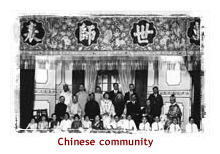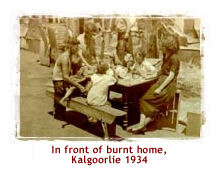 |
Race and secession
 In the 1930s Western Australia was overwhelmingly white and British.
Small populations of Asians and Europeans from non-English speaking backgrounds
lived in areas of the State. Racism was endemic. Children endured school
yard taunts, families were excluded from community activities, adults were
denied the right to vote and, in extreme cases, acts of racial violence
were taken against whole communities. In the goldfields the belief that
'foreigners' were taking the jobs of English-speaking Australians led to
severe racial tensions. The race riots of 1934 which resulted saw Kalgoorlie's
Italian and Yugoslav residents attacked, their businesses destroyed and
their homes burnt.
In the 1930s Western Australia was overwhelmingly white and British.
Small populations of Asians and Europeans from non-English speaking backgrounds
lived in areas of the State. Racism was endemic. Children endured school
yard taunts, families were excluded from community activities, adults were
denied the right to vote and, in extreme cases, acts of racial violence
were taken against whole communities. In the goldfields the belief that
'foreigners' were taking the jobs of English-speaking Australians led to
severe racial tensions. The race riots of 1934 which resulted saw Kalgoorlie's
Italian and Yugoslav residents attacked, their businesses destroyed and
their homes burnt. 
Yet for all the hardships faced by these groups, Western Australia's Aboriginal
people endured the most oppressive discrimination, the result of racism,
indifference and well-intentioned meddling. Government policy imposed assimilation
through a native settlement scheme which removed 'half-castes' from their
families and taught them the 'white man's ways'. Efforts by the white community
to segregate Aboriginals in 'town reserves' - many towns through the south
west were declared off-limits - also placed Aboriginals in appalling living
conditions with malnutrition, disease, poverty and unemployment.
In 1928 a delegation of Aborigines met with Premier Philip Collier to protest
the unjust and repressive laws under which they lived. Although receiving
a sympathetic response from sections of the press, they were unsuccessful.
In 1936 the Native Administration Bill, updating the 1905 Act, gave even
greater powers to the Chief Protector of Aborigines, Mr A.O. Neville. These
were carried out in his name by local police. The Bill extended definitions
of who would be considered a 'native' to include all Aboriginal people except
'quadroons' - one fourth Aboriginal - over the age of 21 and 'octaroons'
- one eighth Aboriginal - thereby depriving many people of mixed descent
the right to conduct their own affairs. Travel, work, the income derived
from work, the ability to live in any location, to frequent public places
like hotels, and to raise families free from interference, were all denied
Aboriginal people of the 1930s.
As with Asian and non-English residents, the issue of secession meant little
to Aboriginal Western Australians.
|
 |